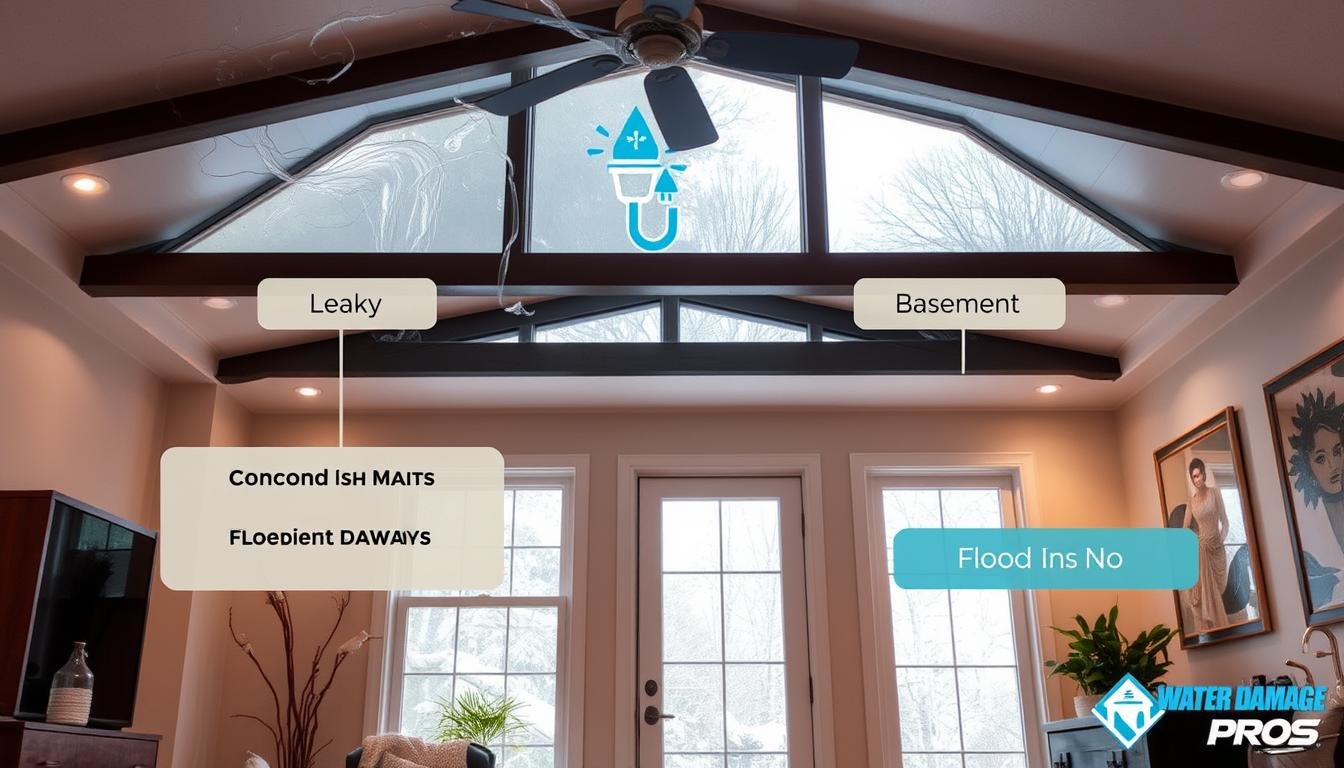Did you know a single inch of standing water can cause up to $25,000 in damage to your home1? Water damage is a big problem for homeowners. Knowing where water damage is most likely to happen helps you protect your home and stuff.
Your home’s basement, bathrooms, kitchens, roofs, and areas around windows and doors are at high risk1. Basements, being below ground, are especially at risk of flooding. They need sump pumps and good drainage to keep water out1. Bathrooms, kitchens, and other places with lots of water sources need regular checks to stop leaks and damage1.
Damaged or old roofs can let water in, making regular checks and fixes very important1. Also, windows and doors that aren’t sealed right can let water in during storms. So, it’s key to seal them well to keep water out1.
Key Takeaways
- Basements, bathrooms, kitchens, roofs, and areas around windows and doors are high-risk areas for water damage.
- Basements require sump pumps and proper drainage systems to prevent flooding.
- Regular maintenance of plumbing systems and sealing of openings can help mitigate water damage risks.
- Damaged or aging roofs must be inspected and repaired promptly to prevent water penetration.
- Proper weatherproofing and sealing of windows and doors can prevent water intrusion during storms.
Sources and Causes of Water Damage
Water damage is a big threat to homes. It can weaken the structure and cost a lot to fix. Knowing where water damage comes from is key for homeowners to prevent it2.
Plumbing Issues
Plumbing problems are a top cause of water damage. Leaks in pipes, broken faucets, and other issues can cause water to build up inside walls and floors. This can lead to mold and damage to the structure2.
Leaks from washing machines can flood a laundry room fast2. Also, faulty sprinkler systems or leaking water heaters can cause a lot of damage in basements2.
Weather-Related Factors
Bad weather like heavy rain and storms can also cause water damage. It can overwhelm drainage systems and let water into weak spots2. Clogged gutters can cause rainwater to overflow, damaging ceilings, walls, and floors2.
Structural Vulnerabilities
The design and build of a home can make it more prone to water damage. Problems like unsealed windows and doors, poor ventilation, and foundation cracks can let water in. This can lead to moisture buildup and mold2.
Condensation from air conditioning can also harm floors, walls, and insulation if drainage is blocked2.
It’s important for homeowners to tackle these water damage sources. Spotting signs like water stains, musty smells, and illness can help prevent bigger problems3.

Exterior Measures for Prevention
Your home’s exterior is key to keeping it safe from water damage. Taking care of outdoor parts and designing them wisely can help a lot. Focus on gutters, downspouts, grading, landscaping, and drainage to prevent water damage.
Gutter and Downspout Maintenance
Gutters and downspouts are vital for your home’s water flow. Clean them often and make sure downspouts reach far enough to avoid water damage. Cleaning gutters in spring and fall stops water overflow, which can harm your roof, siding, and foundation4.
Extending downspouts a few feet from your foundation stops water from pooling. This reduces the chance of your home’s structure getting damaged4.
Grading, Landscaping, and Drainage Systems
Make sure your yard slopes away from your home to keep water away. Choose plants wisely and install drainage systems like French drains. These steps can greatly lower the risk of water damage4.
Grading your yard right helps water flow away from your foundation. This stops water from gathering near walls and basements, which can lead to leaks and flooding4.
French drains and other systems can move water away from danger zones. This helps prevent water from getting into your home and causing damage4.
“According to the Insurance Information Institute, proper water damage prevention can cut down insurance claims and costs.”4
By taking care of these exterior parts, you can lessen water damage’s impact. This protects your home from flooding and moisture problems.
High-Risk Areas Water Damage
Some parts of the home are more likely to get water damage. Basements, for example, are at high risk because they’re below ground and near water56. It’s important to waterproof basements, install sump pumps, and protect crawl spaces and attics to reduce these risks.
Attics can also face water damage, mainly from leaky roofs or condensation6. Keeping roofs in good shape and ensuring attics are well-ventilated can help avoid problems. Crawl spaces, often ignored, can also get moisture issues. They need good ventilation, insulation, and vapor barriers to stay dry.
Bathrooms and kitchens are also at risk because of plumbing and appliances5. Regular checks and upkeep of these systems, along with using water-resistant materials, can help prevent water damage and mold in these areas.
| High-Risk Area | Potential Causes | Preventative Measures |
|---|---|---|
| Basements | – Proximity to groundwater – Concrete walls susceptible to water intrusion – Higher risk of flooding | – Waterproofing – Sump pump installation – Proper drainage and grading |
| Attics | – Leaky roofs – Condensation buildup | – Regular roof inspections and maintenance – Proper ventilation |
| Crawl Spaces | – Moisture seepage – Humidity buildup | – Vapor barrier installation – Proper ventilation – Insulation |
| Bathrooms and Kitchens | – Plumbing fixture leaks – Moisture from sinks and appliances | – Regular plumbing system maintenance – Use of water-resistant materials |
Identifying and fixing high-risk areas for water damage can protect homes and save money. All Dry provides services like mold removal, drying, water extraction, and dehumidification. They offer emergency services 24/7 for quick help.
“Addressing water damage issues in the home is crucial not only for preserving the structural integrity of the property but also for maintaining a healthy and safe living environment.”
Conclusion
Keeping your home safe from water damage prevention is key for homeowners. Knowing where water damage comes from and how to stop it is important. By taking steps to protect your home’s exterior and fixing high-risk areas, you can avoid expensive repairs and long-term damage7.
Being proactive helps a lot. Regular maintenance, being ready for disasters, and using materials that resist water are good steps. These actions protect your home and family from water damage. They also help keep your property value high and reduce the need for insurance claims8.
Checking your home often, keeping your plumbing and drainage in good shape, and fixing weak spots are crucial. These actions help keep your home safe from water damage. By doing these things, you can feel confident that your home is well-protected8.
FAQ
What are some common causes of water damage in homes?
How can proper exterior maintenance help prevent water damage?
What are some high-risk areas for water damage in a home?
How can homeowners proactively prevent water damage?
Why is it important to address water damage issues promptly?
Source Links
- https://www.puroclean.com/ormond-beach-puroclean-ormond-beach/blog/how-to-handle-water-damage-in-high-risk-areas-of-your-home/
- https://www.thesilverlining.com/westbendcares/blog/what-are-the-common-causes-of-water-damage
- https://blueteamcorp.com/common-risks-of-water-damage/
- https://staysafe.org/home-safety/home-water-damage-prevention-protecting/
- https://www.myalldry.com/blog/2023/may/in-what-areas-of-the-home-is-water-damage-most-l/
- https://www.servprothewoodlands.com/blog/post/433449/water-damage-restoration/water-damage-prevention-in-high-risk-areas-basements-attics-and-crawl-spaces
- https://www.marshmma.com/us/insights/details/cautionary-tales-of-water-damage.html
- https://medium.com/@rapidresponserestoration/the-most-common-causes-of-residential-water-damage-9d0e08da49f8


